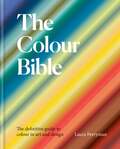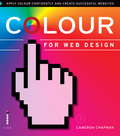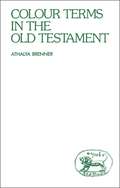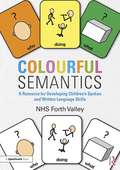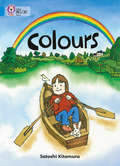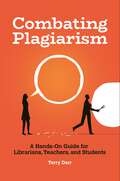- Table View
- List View
Colossians BNTC (Black's New Testament Commentaries)
by Paul FosterFoster provides the commentary on Colossians in this renowned series of biblical commentaries, under the General Editorship of Professor Morna D. Hooker (Lady Margaret Professor of Divinity Emerita in the University of Cambridge, UK). As with other volumes in the series, the key questions for scholars are scrutinised thoroughly - questions of historicity, the use of historical traditions and sources, the relationship of Colossians to the rest of the New Testament in particular the Pauline letters, authorship, and setting. Foster examines these issues in such a way as to present the heart of the academic debate to a wider audience, as befitting to the series reputation for rigorous commentary, which not only advances the knowledge of students and pastors, but also makes a contribution to the academic discourse in its own right.
Colossians BNTC (Black's New Testament Commentaries)
by Paul FosterFoster provides the commentary on Colossians in this renowned series of biblical commentaries, under the General Editorship of Professor Morna D. Hooker (Lady Margaret Professor of Divinity Emerita in the University of Cambridge, UK). As with other volumes in the series, the key questions for scholars are scrutinised thoroughly - questions of historicity, the use of historical traditions and sources, the relationship of Colossians to the rest of the New Testament in particular the Pauline letters, authorship, and setting. Foster examines these issues in such a way as to present the heart of the academic debate to a wider audience, as befitting to the series reputation for rigorous commentary, which not only advances the knowledge of students and pastors, but also makes a contribution to the academic discourse in its own right.
Colour (Documents Of Contemporary Art Ser.)
by David BatchelorThis chronological anthology reflects on the aesthetic, cultural and philosophical meaning of colour to artists within the broader context of anthropology, film, philosophy and science. Those who loathe colour have had as much to say as those who love it. Establishing colour as a central theme in the story of modern art, this is an indispensable handbook to the definitions and debates around its history, meaning and use.
Colour, Art and Empire: Visual Culture and the Nomadism of Representation
by Natasha EatonColour, Art and Empire explores the entanglements of visual culture, enchanted technologies, waste, revolution, resistance and otherness. The materiality of colour offers a critical and timely force-field for approaching afresh debates on colonialism. This book analyses the formation of colour and politics as qualitative overspill. Colour can be viewed both as central and supplemental to early photography, the totem, alchemy, tantra and mysticism. From the eighteenth-century Austrian Empress Maria Theresa to Rabindranath Tagore and Gandhi, to 1970s Bollywood, colour makes us adjust our take on the politics of the human sensorium as defamiliarising and disorienting. The four chapters conjecture how European, Indian and Papua New Guinean artists, writers, scientists, activists, anthropologists or their subjects sought to negotiate the highly problematic stasis of colour in the repainting of modernity. Specifically, the thesis of this book traces Europeans' admiration and emulation of what they termed 'Indian colour' to its gradual denigration and the emergence of a 'space of exception'.This space of exception pitted industrial colours against the colonial desire for a massive workforce whose slave-like exploitation ignited riots against the production of pigments - most notably indigo. Feared or derided, the figure of the vernacular dyer constituted a force capable of dismantling the imperial machinations of colour. Colour thus wreaks havoc with Western expectations of biological determinism, objectivity and eugenics. Beyond the cracks of such discursive practice, colour becomes a sentient and nomadic retort to be pitted against a perceived colonial hegemony. The ideological reinvention of colour as a resource for independence struggles make it fundamental to multivalent genealogies of artistic and political action and their relevance to the present.
The Colour Bible: The definitive guide to colour in art and design
by Laura PerrymanAn essential source for graphic designers, artists, interior designers, fashion designers, illustrators and creatives of any kind who work with colour.Colour is intrinsic to the human experience; it guides us with subconscious visual cues throughout our lives. Get it right in your design or art and you can enhance mood and atmosphere, and create a desired psychological or even physiological effect. The Colour Bible is a contemporary handbook for navigating this fascinating world of colour. It dives into 100 profiles of significant colours and tracks them through their genesis, historical usage in art and design, and contemporary connotations and uses. - A potted history of each colour- Key colour associations from around the world- Contemporary connotations and brand design- Practical advice on how to use and combine colours in your work
Colour Coding for Learners with Autism: A Resource Book for Creating Meaning through Colour at Home and School (PDF)
by Adele DevineChildren on the autism spectrum are often highly visual learners, making colour a powerful and motivating learning tool. This book explains how colour coding helps young people with autism to generalise lessons already learnt. For example, assigning the colour aqua to all personal care activities or the colour purple to timetabling and transitions establishes clear, visual categories. This allows children to draw on learnt experiences, which creates a sense of order, reduces anxiety, and can aid communication, understanding emotions, organisation, coping with change and diversifying diet. A wealth of tried-and-tested printable resources to enable the practical application of colour coding in the classroom and at home are included on a CD-ROM. With colourful illustrations and resources, Colour Coding for Learners with Autism is an effective, must-have teaching tool for anyone involved in the education of young people with autism.
Colour for Architecture Today
by Tom Porter Byron MikellidesWhat role does colour play in our built environment? How are our attitudes to colour changing? What potential do new technologies bring for the use of colour and light in architecture? Combining real examples from practice with colour theory, this book will help you to fully understand the role and impact of colour in our urban spaces. Contributions from leading architects Will Alsop, Legorreta and Legorreta, John Outram, Sauerbruch Hutton and Neuterlings Riedijk accompany those from artists Alain Bony and Yann Kersalé, and from colour researchers such as Kristina Enberg and Anders Hård, who developed the Natural Colour System. Topics include: how and why we see colour methodologies in the documentation of traditional colours the development of new urban palettes recent colour psychology research the effect of light levels on human behaviour dramatic colour effects achievable with light guidelines for future deployment of colour in the built environment. This is a sequel to the immensely influential Colour for Architecture, published in 1976. Much has changed in 30 years; new cutting edge technologies and materials have emerged allowing architects to experiment with colour and light in an energy efficient and sustainable way, paving the way for a more colourful and exciting built environment.
Colour for Architecture Today
by Tom Porter Byron Mikellides Terry FarrellWhat role does colour play in our built environment? How are our attitudes to colour changing? What potential do new technologies bring for the use of colour and light in architecture? Combining real examples from practice with colour theory, this book will help you to fully understand the role and impact of colour in our urban spaces. Contributions from leading architects Will Alsop, Legorreta and Legorreta, John Outram, Sauerbruch Hutton and Neuterlings Riedijk accompany those from artists Alain Bony and Yann Kersalé, and from colour researchers such as Kristina Enberg and Anders Hård, who developed the Natural Colour System. Topics include: how and why we see colour methodologies in the documentation of traditional colours the development of new urban palettes recent colour psychology research the effect of light levels on human behaviour dramatic colour effects achievable with light guidelines for future deployment of colour in the built environment. This is a sequel to the immensely influential Colour for Architecture, published in 1976. Much has changed in 30 years; new cutting edge technologies and materials have emerged allowing architects to experiment with colour and light in an energy efficient and sustainable way, paving the way for a more colourful and exciting built environment.
Colour for Web Design: Apply Colour Confidently and Create Successful Websites
by Cameron ChapmanColour is one of the most powerful tools at a designer's disposal, yet few truly understand how much it can do for them, and the immediate difference it will make to the popularity and success of their website.This is the complete guide to creating a unique, practical and appropriate colour palette for any web design project. Building on the basics, starting with essential - often misunderstood - terminology and an understanding of traditional colour palettes, the book then moves on to practical, real-world examples of sites with fantastic colour schemes.A one-stop shop for a complete knowledge of digital colour, this book will give the designer the confidence to create their own palettes and apply colour successfully to their designs.
Colour in Glazes (New Ceramics)
by Linda BloomfieldA complete guide to achieving a fantastic spectrum of colourful glazes for the studio potter, Colour in Glazes looks at all the methods of achieving colour in glazes, focusing on colouring oxides in detail, including the newly available rare earth oxides. Types of base glazes and the fluxes used to make them are discussed in relation to colour response. Emphasis is placed on using colouring oxides to achieve depth and variety of colour, rather than just resorting to commercial ceramic stains. The practical aspects of mixing, applying, testing and adjusting glazes are explained and a large section of test tiles and glaze recipes is included, for use on white earthenware, stoneware and porcelain fired in electric, gas and salt kilns. A very useful book aimed at making glazes to achieve the colour you want, and to help you broaden your palette.
Colour in Glazes (New Ceramics)
by Linda BloomfieldA complete guide to achieving a fantastic spectrum of colourful glazes for the studio potter, Colour in Glazes looks at all the methods of achieving colour in glazes, focusing on colouring oxides in detail, including the newly available rare earth oxides. Types of base glazes and the fluxes used to make them are discussed in relation to colour response. Emphasis is placed on using colouring oxides to achieve depth and variety of colour, rather than just resorting to commercial ceramic stains. The practical aspects of mixing, applying, testing and adjusting glazes are explained and a large section of test tiles and glaze recipes is included, for use on white earthenware, stoneware and porcelain fired in electric, gas and salt kilns. A very useful book aimed at making glazes to achieve the colour you want, and to help you broaden your palette.
The Colour of Class: The educational strategies of the Black middle classes
by Nicola Rollock David Gillborn Carol Vincent Stephen J. BallHow do race and class intersect to shape the identities and experiences of Black middle-class parents and their children? What are Black middle-class parents’ strategies for supporting their children through school? What role do the educational histories of Black middle-class parents play in their decision-making about their children’s education? There is now an extensive body of research on the educational strategies of the white middle classes but a silence exists around the emergence of the Black middle classes and their experiences, priorities, and actions in relation to education. This book focuses on middle-class families of Black Caribbean heritage. Drawing on rich qualitative data from nearly 80 in-depth interviews with Black Caribbean middle-class parents, the internationally renowned contributors reveal how these parents attempt to navigate their children successfully through the school system, and defend them against low expectations and other manifestations of discrimination. Chapters identify when, how and to what extent parents deploy the financial, cultural and social resources available to them as professional, middle class individuals in support of their children’s academic success and emotional well-being. The book sheds light on the complex, and relatively neglected relations, between race, social class and education, and in addition, poses wider questions about the experiences of social mobility, and the intersection of race and class in forming the identity of the parents and their children. The Colour of Class: The educational strategies of the Black middle classes will appeal to undergraduates and postgraduates on education, sociology and social policy courses, as well as academics with an interest in Critical Race Theory and Bourdieu. The Colour of Class was awarded 2nd prize by the Society for Educational Studies: Book Prize 2016.
The Colour of Class: The educational strategies of the Black middle classes
by Nicola Rollock David Gillborn Carol Vincent Stephen J. BallHow do race and class intersect to shape the identities and experiences of Black middle-class parents and their children? What are Black middle-class parents’ strategies for supporting their children through school? What role do the educational histories of Black middle-class parents play in their decision-making about their children’s education? There is now an extensive body of research on the educational strategies of the white middle classes but a silence exists around the emergence of the Black middle classes and their experiences, priorities, and actions in relation to education. This book focuses on middle-class families of Black Caribbean heritage. Drawing on rich qualitative data from nearly 80 in-depth interviews with Black Caribbean middle-class parents, the internationally renowned contributors reveal how these parents attempt to navigate their children successfully through the school system, and defend them against low expectations and other manifestations of discrimination. Chapters identify when, how and to what extent parents deploy the financial, cultural and social resources available to them as professional, middle class individuals in support of their children’s academic success and emotional well-being. The book sheds light on the complex, and relatively neglected relations, between race, social class and education, and in addition, poses wider questions about the experiences of social mobility, and the intersection of race and class in forming the identity of the parents and their children. The Colour of Class: The educational strategies of the Black middle classes will appeal to undergraduates and postgraduates on education, sociology and social policy courses, as well as academics with an interest in Critical Race Theory and Bourdieu. The Colour of Class was awarded 2nd prize by the Society for Educational Studies: Book Prize 2016.
The Colour Photography Field Guide: The Essential Guide to Hue for Striking Digital Images (Field Guide)
by Michael FreemanUnderstand the role colour plays in your images, learn to appreciate its dynamic effects and find out how to capture and reproduce it as precisely as possible in your own images.The Colour Photography Field Guide provides a unique look at analysing and combining three important ways of dealing with colour. The first is the subjective and cultural response to individual colour: the perception. The second is how colours are found and appear in photography: the science. The third is the means by which they can be viewed and altered digitally: the expression.- A clear and technically precise look at how colour affects your digital images- Portable and lightweight, for on-the-spot information and inspiration- With a host of case studies examining difficult colour situations such as capturing flesh tones and unreal colours
Colour Terms in the Old Testament (The Library of Hebrew Bible/Old Testament Studies)
by Athalya Brenner-IdanThe OT semantic field of 'colour' is presented as a coherent, interdependent, and graded linguistic structure. The relevant lexical items are organized under the following categories: primary (basic) terms; secondary and tertiary terms; terms for pigments, dyes, painting and paints; and terms for stains, speckles, and other phenomena related to colour. Proper names, and names of objects which carry 'colour' associations are discussed as well. Many OT texts are discussed in detail. Finally, the OT colour field is compared to its Mishnaic Hebrew counterpart, and an Appendix dealing with the renewal of the same lexical sector within modern spoken Hebrew brings the study up to the present.
Colour Third Edition: A workshop for artists, designers
by David HornungTaking a practical approach to colour, Colour: A workshop for artists and designers is an invaluable resource for art students and professionals alike. With its sequence of specially designed assignments and in-depth discussions, it effectively bridges the gap between colour theory and practice to inspire confidence and understanding in anyone working with colour. This third edition is updated with more contemporary examples drawn not just from painting, but from textiles, graphic design, illustration and animation. An expanded discussion of digital techniques, new assignments and a refreshed design have all been brought together to create a highly readable and relevant text.
Colourful Semantics: A Resource for Developing Children’s Spoken and Written Language Skills
by NHS Forth ValleyThis comprehensive resource pack, developed in conjunction with education staff, draws on the principles of Alison Bryan’s original Colourful Semantics approach to provide professionals with an engaging, dynamic way to support children’s language development. By coding sentences using colour, symbols and signs, this visual approach aims to: Teach understanding of question words Develop vocabulary and increase sentence complexity Increase range and complexity of verbs (children with delayed or disordered spoken language skills often overuse simple verbs such as do, go or get) Improve children’s written language skills This practical resource consists of three parts: a printed book containing ready-made session plan ideas, black and white vocabulary cards and worksheets; an online version using the current Colourful Semantics colour coding system, and an online version using the colour coding system used by Speech and Language Therapists from NHS Forth Valley. This is an essential pack for teachers and professionals looking to work on language development with children aged four to nine. The flexible session plans can be used with individuals, small groups and whole classes, and can be easily adapted by Speech and Language Therapists, teachers and other practitioners.
Colourful Semantics: A Resource for Developing Children’s Spoken and Written Language Skills
by NHS Forth ValleyThis comprehensive resource pack, developed in conjunction with education staff, draws on the principles of Alison Bryan’s original Colourful Semantics approach to provide professionals with an engaging, dynamic way to support children’s language development. By coding sentences using colour, symbols and signs, this visual approach aims to: Teach understanding of question words Develop vocabulary and increase sentence complexity Increase range and complexity of verbs (children with delayed or disordered spoken language skills often overuse simple verbs such as do, go or get) Improve children’s written language skills This practical resource consists of three parts: a printed book containing ready-made session plan ideas, black and white vocabulary cards and worksheets; an online version using the current Colourful Semantics colour coding system, and an online version using the colour coding system used by Speech and Language Therapists from NHS Forth Valley. This is an essential pack for teachers and professionals looking to work on language development with children aged four to nine. The flexible session plans can be used with individuals, small groups and whole classes, and can be easily adapted by Speech and Language Therapists, teachers and other practitioners.
Colours: Band 04/blue (Collins Big Cat)
by Satoshi KitamuraA simple text where a visit to an art show causes a girl to imagine what the world would be like if it was wholly yellow, red or blue. Realising that the world actually consists of all the colours of the rainbow, she paints lots of multicoloured pieces of art herself.
Colours: A Drawing Book Inspired by Art (True Colour Ser.)
by Giovanna RanaldiMany people crave a creative outlet, but more often than not, don't know where to start. In Colours, Giovanna Ranaldi invites you to nurture your creativity and build your confidence by taking inspiration from famous works of art that celebrate colour.Each section explores a particular aspect of colour, from basics such as the history of the colour wheel and using complementary colours, to understanding the impact colour has on our emotions and dreams. Throughout the book, Giovanna provides creative and fun prompts that will encourage you to draw or paint on the pages using various techniques. Colours is full of information on how to see colour and use it in your own artwork and is packed with inspiration from the world's most celebrated artists, including Paul Klee, Claude Monet, Vincent van Gogh, Sonia Delaunay and more.Colours is a short course in unlocking your creative self – perfect for budding artists of all ages who are keen to try out different artistic techniques and materials, and begin their artistic journey.
Colours and Shapes Flashcards 3+ (Collins Easy Learning Preschool)
by Collins Easy LearningLevel: EYFS. Subject: Maths. The perfect resource for learning colours and shapes at home!
Combating Educational Disadvantage: Meeting the Needs of Vulnerable Children
by Theo CoxThe New Labour Government puts Education, Education, Education at the heart of its agenda but is it doing enough to combat educational disadvantage?Combating Educational Disadvantage sets the discussion of educational disadvantage within the socio-political context of the 1980s and 1990s, with its market philosophy in education and brings together the contributions of leading writers and researchers of international standing.
Combating Educational Disadvantage: Meeting the Needs of Vulnerable Children
by Theo CoxThe New Labour Government puts Education, Education, Education at the heart of its agenda but is it doing enough to combat educational disadvantage?Combating Educational Disadvantage sets the discussion of educational disadvantage within the socio-political context of the 1980s and 1990s, with its market philosophy in education and brings together the contributions of leading writers and researchers of international standing.
Combating Plagiarism: A Hands-On Guide for Librarians, Teachers, and Students
by Terry DarrOffers an instructional plan for plagiarism education for middle school and high school students, allowing librarians to become a resource for students, teachers, and school administrators.The proliferation of resources now available through libraries and the internet requires a new set of information management skills in order for students to avoid plagiarism. While educators legitimately expect students to approach academic work with honesty and integrity, students need to be able to understand the context of their academic resources—both print and digital—well enough to use them appropriately and ethically. Combating Plagiarism helps middle and high school teachers and librarians understand and teach the authorship and publication process so students learn to use relevant information in an ethically and academically sound fashion.Terry Darr's long-term collaboration with a high school history teacher taught her the challenges faced by students conducting research—and by librarians and teachers tasked with teaching plagiarism prevention. Her book is full of tested concepts for teaching these complex topics, emphasizing our modern reliance on digital sources. An extensive student reference section covers common knowledge, fact, and opinion. A wealth of practical resources includes real-life examples from research papers as well as plenty of instructional materials, exercises, and lesson plans.
Combating Plagiarism: A Hands-On Guide for Librarians, Teachers, and Students
by Terry DarrOffers an instructional plan for plagiarism education for middle school and high school students, allowing librarians to become a resource for students, teachers, and school administrators.The proliferation of resources now available through libraries and the internet requires a new set of information management skills in order for students to avoid plagiarism. While educators legitimately expect students to approach academic work with honesty and integrity, students need to be able to understand the context of their academic resources—both print and digital—well enough to use them appropriately and ethically. Combating Plagiarism helps middle and high school teachers and librarians understand and teach the authorship and publication process so students learn to use relevant information in an ethically and academically sound fashion.Terry Darr's long-term collaboration with a high school history teacher taught her the challenges faced by students conducting research—and by librarians and teachers tasked with teaching plagiarism prevention. Her book is full of tested concepts for teaching these complex topics, emphasizing our modern reliance on digital sources. An extensive student reference section covers common knowledge, fact, and opinion. A wealth of practical resources includes real-life examples from research papers as well as plenty of instructional materials, exercises, and lesson plans.




